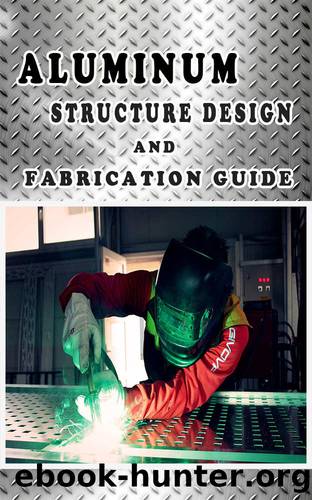ALUMINUM STRUCTURE DESIGN AND FABRICATION GUIDE by BNRS Mustapha

Author:BNRS, Mustapha
Language: eng
Format: epub
Publisher: UNKNOWN
Published: 2022-02-05T16:00:00+00:00
Chapter 7 Joining Aluminum to Steel Structure
7.1 Introduction Aluminum has been used for more than 100 years in the deckhouses and superstructures of ships, particularly combatant ships and passenger vessels in order to reduce high topside weight and improve stability. A review of that history was given by Sielski (1987). That history will be discussed here, with an emphasis on problem areas to ensure that those problems will be avoided in future construction. Many of the past problems were due to poor material selection, which can be avoided by use of approved marine aluminum alloys, but others were design problems involving poor structural details or improper mixing of metals.
7.2 Riveted Joints The U.S. Navy began using aluminum for the deckhouses of destroyers in 1936. The structure was transversely framed with steel, and aluminum panels were riveted to the frames and to each other. In some cases, plating was mixed, with steel used in some locations, especially were a small amount of armor protection was desired. A detail of the aluminum-tosteel connection is shown in Figure 7-1.
Figure 7-1 Typical mild steel frame with aluminum plate in U.S. Navy DD 693 Class destroyers. This practice of using steel framing with aluminum and steel plate was used by the U.S. Navy for destroyer deckhouses until 1948. Following the war, the development of aluminum welding had an effect, and in 1948 the new destroyer leaders, the USS Mitcher (DL-2) Class had aluminum deckhouses that were entirely welded, including the transversely oriented frames. Although the Dealy (DE-l008) Class started with steel deckhouses, weight growth led to an aluminum deckhouse on USS Courtney (DE 1021) when contracted in 1953 and on subsequent ships of the class. From then until the mid-1980s, all new U.S. Navy combatant ships (destroyers, destroyer escorts, frigates and cruisers) had aluminum for the majority of their deckhouses. In addition, aluminum was used for the deckhouse in landing ships and for the islands of aircraft carriers and amphibious assault ships.
The hulls of the ships were of steel, and the aluminum was mechanically fastened to the steel at a coaming similar to that in Figure 7-2. With this type of mechanical connection between steel and aluminum, insulating material must be placed between the two metals to avoid galvanic corrosion. Typically, rubber electrical tape was used. However, this insulation often broke down, and corrosion would occur at these joints, similar to that shown in Figure 7-3. The joint would absorb moisture, and alternate drying and wetting with seawater would build up the concentration of salt deposits, and so any breakdown of the insulation, especially at points of stress concentration, would lead to rapid corrosion. This problem was exacerbated in the earlier ships because some of the aluminum plate was prone to exfoliation. Dye and Dawson (1974) described many of the maintenance problems that occurred in these aluminum deckhouses, and they offered recommendations for repairs.
Figure 7-2 Riveted connection of an aluminum deckhouse to a steel deck at an expansion joint.
Figure 7-3 Riveted connection with corrosion in the aluminum (Dye and Dawson, 1974)
7.
Download
This site does not store any files on its server. We only index and link to content provided by other sites. Please contact the content providers to delete copyright contents if any and email us, we'll remove relevant links or contents immediately.
Harry Potter and the Goblet Of Fire by J.K. Rowling(3046)
Never by Ken Follett(2881)
Shadow of Night by Deborah Harkness(2718)
Ogilvy on Advertising by David Ogilvy(2682)
Zero to IPO: Over $1 Trillion of Actionable Advice from the World's Most Successful Entrepreneurs by Frederic Kerrest(2396)
The Man Who Died Twice by Richard Osman(2300)
Machine Learning at Scale with H2O by Gregory Keys | David Whiting(2292)
Book of Life by Deborah Harkness(2263)
How Proust Can Change Your Life by Alain De Botton(2261)
My Brilliant Friend by Elena Ferrante(2224)
0041152001443424520 .pdf by Unknown(2220)
The Tipping Point by Malcolm Gladwell(2204)
How to Pay Zero Taxes, 2018 by Jeff A. Schnepper(2100)
Will by Will Smith(2042)
Purple Hibiscus by Chimamanda Ngozi Adichie(1982)
Hooked: A Dark, Contemporary Romance (Never After Series) by Emily McIntire(1960)
Borders by unknow(1785)
Rationality by Steven Pinker(1765)
Daughter of Smoke and Bone by Laini Taylor(1744)
